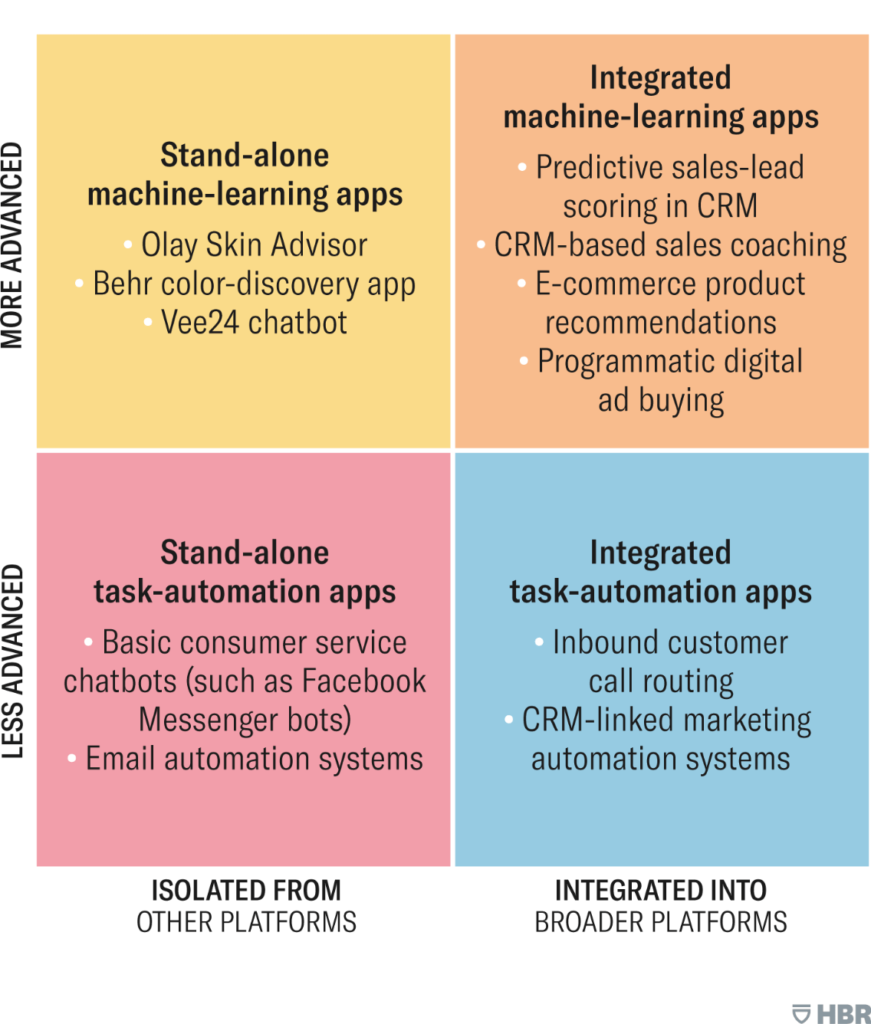When you think of artificial intelligence (AI), you probably think of human-looking robots. Maybe a bit of fear mixed with a pinch of excitement. Whatever you think of, you most likely don’t pair it with marketing.

The thing is, you can. And here’s why you should. AI can improve the customer experience and handle your data more efficiently. Plus, as a bonus, it just sounds cool.
Marketers, here’s how to make your content marketing more accurate with half the effort.
What is artificial intelligence (AI) for marketing?
Artificial intelligence technology is used to make automated decisions. It’s mostly used when things need to be decided fast. In terms of marketing automation, these will be based on data and audience trends.
AI marketing use cases are things like:
- Analyzing data
- Natural language processing (NLP)
- Content marketing
- Personalized responses
- Customer segmentation
- Lead scoring in CRM (Customer Relationship Management)

Marketing AI can be a stand-alone tool or part of a bigger platform.
Artificial intelligence assistants, like Amazon’s Alexa, are already living in customers’ homes. It’s a way of increasing the size and capability of your marketing team without hiring anyone new.
By using techniques like machine learning, it becomes easier to guess the user’s next move. Once you get really good at that, you can improve the customer journey as a whole. AI is the future of digital marketing. And the future’s here.
Marketing task automation vs. machine learning
Stripping it right down, there are 2 main types of intelligence:
- Task automation
- Machine learning
So, how do they differ?
Here’s a comparison using information from HBR:
| Task Automation | Machine Learning |
| Repetitive, structured tasks | Trained using large amounts of data |
| Interacts through basic decision trees | Able to segment customers |
| Usually requires low levels of intelligence | Can make pretty complex decisions |
| Follows a set of rules | Able to recognize images and interpret text |
| Can’t handle complex problems | Drives programmatic buying (online advertising) |
| Can’t work out customer intent or offer personalized responses | Can predict how people will react to certain things |
| E.g. Sending a welcome email to a new customer | E.g. Chatbots that offer personalized responses based on intent |
If you want to go deeper, there are actually four stages of intelligence. From simple mass processing to intelligent, self-learning systems.
Here’s a quick diagram that explains:

Machine learning is when technology learns new skills based on experience. Similar to how humans learn.
Deep learning happens when an artificial ‘brain’ uses a large amount of data and algorithms to mimic human neural networks. It will repeat a task over and over and tweak its response to improve the result.
According to Forbes,
“We refer to ‘deep learning’ because the neural networks have various (deep) layers that enable learning. Just about any problem that requires “thought” to figure out is a problem deep learning can learn to solve.”
Gnarly.
But before it gets to that level, it’s just plain old machine learning.
So, why should you use machine learning marketing in your business?
Benefits of using machine learning for marketing
There are plenty of arguments for AI marketing.
It might seem like a pipe dream for your business, but it’s more achievable than you think.
Of course, there are different levels of artificial intelligence. Some will be a lot more complex than others. But we’ll get to that in a bit.
Here are 3 of the most popular benefits of using machine learning for marketing:
- Personalizing the customer journey
- Making more informed advertising decisions
- Saving time and money creating content
A more personalized experience for your audience
One of the biggest benefits of machine learning for marketing is how much it can personalize things for your customers.
People love Starbucks because they see their name (or someone’s name) on a cup. (“Claudia” in a Scottish accent can produce a variety of results.)

‘Predictive analytics’ takes all of your customer data and makes better decisions based on what your user prefers.
Think about Netflix recommending shows based on your past viewing. Or when Amazon recommends products you might like based on what you’ve already bought. This is AI machine learning in action.

Twitter for Business said,
“As a marketer, if you can develop a set of data points that let you guide users to a specific product or service that is very powerful. Make solving a users’ problem easy for them.”
It can even happen behind the scenes. Machine learning that seems to present customers with a well-rounded personalized experience just after onboarding.
This also applies to providing more relevant ads. Ads that change depending on the season, your location, and even the weather.
Personalization from AI marketing meets (and sometimes exceeds) your customer needs.
But happier customers = better customer relationships. And loyal customers = higher conversion rates.
Better decision making for advertising
Yes, ads can be annoying. But unless you’re personally paying to use a site, ads keep them funded.
So, would you (as a consumer) rather look at ads that don’t appeal to you at all? Or see some stuff you might actually want to buy?
According to the McKinsey Global Institute, AI and machine learning are on track to generate between $1.4 – $2.6 trillion over the next 3 years. All by solving marketing and sales problems.
Looking at a ton of data and trying to decide how to target your ads is no easy feat. Luckily for AI, it is.

Machine learning algorithms instantly consider all information they have on specific topics. They then use this to make the best decision.
As it collects more information over time, these become increasingly more accurate.
You want to give your ads the best chance of being seen by people who might actually pay for your product.
Artificial intelligence can make this happen.
Time-saving content creation
In an ideal world, you’d have an extensive marketing team. Creating and publishing content regularly on your site and social media accounts.
For many people, that’s sadly not (yet) financially viable. Here’s where artificial intelligence comes in.
Ranking in the top 10 results on Google is most marketers’ goal.
Since it began, Google’s algorithm has been trying to work out what people actually want to see when they search. As more and more people use it, it’s analyzed and gotten better at predicting.

What better way to tap into the ‘brain’ of the most-used AI tool of all time than using AI yourself?
Did you know, The Washington Post has been using an AI content creation bot called ‘Heliograf’ since 2016?
From Search Engine Optimization (SEO) to proofreading and even copywriting itself, technology can help you out.
If you’re not looking to create your own tool, at least use the power of AI marketing for your content marketing.
Examples of AI marketing tools that use machine learning
Sometimes, the best way to learn is from examples.
Would you like to create your own AI tool? Or are you thinking about implementing one that already exists into your marketing team?
According to Semrush, most marketers are not yet confident in using their data to achieve business goals. But the global AI market is expected to reach $267 billion by 2027.
Sounds like something we all want to be involved in.

Either way, we found some tools that can help you out in the meantime.
As Quuu deals with content marketing, we’ve stuck to that side of things. Plus, a chatbot thrown in for good measure.
Here are three examples of AI marketing tools that use machine learning:
- Jasper (copywriting)
- Drift (chatbot)
- Grammarly (proofreading)
Pricing varies, but what’s affordable will differ from business to business.
Jasper
We’ve all suffered from writer’s block. What do you do when it happens?
If you sit blankly staring at a screen, meet Jasper. Your new AI copywriting assistant.
Simply tell Jasper about what you’re selling, the type of content you want to create, and get ready to be amazed.
Jasper has read about 10% of the internet, so you can bet it knows all about your niche. From e-commerce to blogs, all marketing efforts are covered.
You can even choose the tone you’d like that’s closest to your brand voice.

It’s creative copy that’s emotional and persuasive. All thanks to the expert marketers who trained it.
Jasper writes high-quality AI marketing content that’s:
- Original
- Plagiarism-free
- Optimized for SEO
- And drives sales
That’s pretty wild.
Sound too good to be true? Give it a shot.
Drift Chatbots
Many businesses still rely on contact forms for online users.
Yes, they’re a great way of capturing leads. But they can be pretty impersonal. Not to mention the potentially long wait times for a response.
Chatbots are used to save time, increase inbound traffic, and simplify the customer journey. They basically mean you have a 24-hour customer service team.
They’re also one of the most well-known examples of AI marketing.
According to reviews, Drift makes some of the best in the business:
“They are the best out there and way ahead of any of their competitors or other tech companies trying to simply “add-on” a chat tool.”

Chatbots give visitors to your site real-time answers they need in seconds. Right at their moment of highest intent.
Machine learning means the bots get smarter and more accurate with every conversation. It’s a constant evolution.
Could chatbots enhance your marketing campaigns? Why not find out?
Grammarly
If you’re a content writer, you’ll probably have heard of Grammarly.
It’s a cloud-based AI assistant that proofreads and highlights any mistakes in your writing. This includes:
- Spelling
- Grammar
- Punctuation
- Clarity
- How engaging it is
- Any delivery mistakes
It mixes machine learning with AI capabilities like deep learning and natural language processing. All to improve your writing.

Users can click to ‘ignore’ certain suggestions too that may be incorrect. When lots of people do the same thing, the people behind the AI will adjust the algorithms to make it more accurate in future.
AI is kind of like a kid in that way. It needs to be taught by the people around it, and it’ll always be learning.
Rather than a human manually making their way through your content, Grammarly does it in seconds. There’s even a mobile app too!
A 3-step AI marketing strategy
Remember earlier we talked about task automation vs. machine learning?
Well, even those are subdivided into “less” and “more advanced”.
Take this table for example:

Basic bots (like the Facebook messenger ones) are examples of stand-alone task automation apps. They’re on the “less advanced” end of the scale.
Things like e-commerce product recommendations are integrated machine learning apps. They’re “more advanced”.
If your business has little (or no) AI experience, experts say a good way to begin is “by building or buying simple rule-based applications”.
If that’s you, here’s a 3-step strategy for building or buying an AI marketing tool:
- Start with simple, rule-based applications
- Move from task automation to machine learning
- Progress to fully automated decisions
Start with simple, rule-based applications
First rule: don’t run before you can walk.
You can’t jump into an integrated machine learning app with no experience. You want to start with something that’s non-customer facing.
Maybe something that deals with data analytics. Or one that helps customer service agents who speak to consumers.
It should be rule-based and simple.

Just get to grips with the basics of AI and how you can best utilize it in your business.
Move from task automation to machine learning
You might already have the data you need to create a machine learning app. Otherwise, starting with a basic rule-based one could get you the metrics you need.
Marketing analytics is one of the most popular uses for AI in that sector.
Once you’ve got your basic skills down, it’s time to move from task automation to machine learning.
British retailer ASOS is a great example of this.
ASOS knows how to use machine learning to improve the customer experience:
- You can build an outfit with suggestions that match from an initial ‘seed product’.
- There’s a ‘Fit Assistant’ which helps customers work out if something will fit their body without trying it on.
- They even have a visual search bar called ‘Style Match’. It lets users upload a reference photo and find the closest product matches on the site.

Though it’s impressive, they didn’t have all of those capabilities at the beginning. And any they did have weren’t as advanced.
It was a slow process with AI marketing that has majorly personalized their app. But they’re now one of the world’s most popular fashion retailers.
You could be too in your sector.
Progress to fully automated decisions
Eventually, you’ll want to take humans out of the loop entirely. For some decisions anyway.
“With repetitive, high-speed decisions, such as those required for programmatic ad buying (where digital ads are served up almost instantaneously to users), this approach is essential.”
When it’s the customer that has to make the choice, AI can suggest personalized recommendations.

Humans do still need to be in charge of the most important decisions, though. Anything that could have major consequences if they turn out to be wrong. (“It wasn’t me, dude, it was the AI!”)
Handing over the boring brunt work to technology is one way of streamlining decision-making.
It’s clear. To make the most of AI marketing, companies need to move to more automation.
Conclusion
AI will completely transform marketing one day. However, we’re a while away from that yet.
By adding it into your marketing efforts now, though, you can grow alongside it.
Machine (and deep) learning are the end goals to truly benefit your business. Until then, get to know rule-based task automation.
Handoff some of the easier, everyday decisions to AI. You’ll save a ton of time and money.
It’s as simple as that.
Do you use AI marketing in your business already? Do you have plans to in future? We’d love to know.





